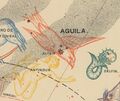Aquila: Difference between revisions
(→Transfer and Transformation of the constellation: added image gallery for Eagle) |
(accent) |
||
| Line 15: | Line 15: | ||
File:1776 - John Flamsteed - L'Aigle, Antinous, La Fleche, Le Renard, Le Dauphin (Aquila, Sagitta, Vulpecula & Anser Delphinus).jpg|Aquila et Antinous, 1776 - Jean Fortin/ John Flamsteed - L'Aigle, Antinous, La Fleche, Le Renard, Le Dauphin (Aquila, Sagitta, Vulpecula & Anser Delphinus, [https://www.raremaps.com/gallery/detail/66194/laigle-antinous-la-fleche-le-renard-le-dauphin-aquila-flamsteed-fortin source]) |
File:1776 - John Flamsteed - L'Aigle, Antinous, La Fleche, Le Renard, Le Dauphin (Aquila, Sagitta, Vulpecula & Anser Delphinus).jpg|Aquila et Antinous, 1776 - Jean Fortin/ John Flamsteed - L'Aigle, Antinous, La Fleche, Le Renard, Le Dauphin (Aquila, Sagitta, Vulpecula & Anser Delphinus, [https://www.raremaps.com/gallery/detail/66194/laigle-antinous-la-fleche-le-renard-le-dauphin-aquila-flamsteed-fortin source]) |
||
File:Aql bode.jpg|The constellation of Aquila (Eagle) and the constellation of Antinous, portrayed as Zeus and Ganymede, from the ''Uranographia'', by Johann Elert Bode (1782). |
File:Aql bode.jpg|The constellation of Aquila (Eagle) and the constellation of Antinous, portrayed as Zeus and Ganymede, from the ''Uranographia'', by Johann Elert Bode (1782). |
||
File:Simon Antinous spanish1894.jpg|Aquila et Antinous at Planisferio celeste (Carlos |
File:Simon Antinous spanish1894.jpg|Aquila et Antinous at ''Planisferio celeste'' (Carlos Simón 1894) |
||
</gallery> |
</gallery> |
||
== Greek Mythology == |
== Greek Mythology == |
||
Revision as of 09:54, 17 September 2024
Aquila, The Eagle, is one of the official IAU-constellations. Its history goes back to a Sumerian constellations (TI8, The Eagle or The Vulture) in the same area of the sky.
Etymology and History
"Aquila" is the Latin transtlation of the Ancient Greek term which is the translation of an Akkadian term which is the translation of a Sumerian term. It is unknown whether the Sumerians distinguished betwen eagles and vultures. The Greek term and mythology clearly refer to an eagle as a symbol of divine power, but the original Sumerian constellation might have had a different context: as it was placed next to the Sumerian constellation of The Corpse, the bird might have been considered a vulture.
Origin of constellation
The constellation is listed in MUL.APIN's first list.
Transfer and Transformation of the constellation
Aquila et Antinous, 1776 - Jean Fortin/ John Flamsteed - L'Aigle, Antinous, La Fleche, Le Renard, Le Dauphin (Aquila, Sagitta, Vulpecula & Anser Delphinus, source)











